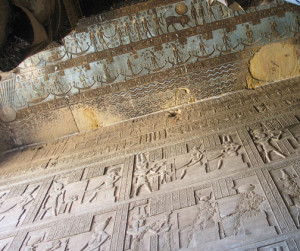At several places within the Temple of Dendera the colors from antiquity were visible. Here you can see the remains of a bluish pigment on the ceiling. The ancient Egyptians used two blues. One is the Egyptian blue frit described in an earlier blog entry and the other azurite. It is impossible to tell which was used here without analyzing a … [Read more...] about Dendera Temple Ceiling Colors
pigments
Shores of the Nile
Baboons and Netherworlds
This stunning necklace is another example of the similar theme as previously posted. This piece is exceptional in its detail and inlay of gems. The lapis scarab is again holding the sun shape. Here you can see the two baboonsflanking the scarab. They are made of turquoise and glass paste with silver. The baboons helped the rising sun come … [Read more...] about Baboons and Netherworlds
Moon Over Kom Ombo
This temple of Kom Ombo is set dramatically on a hill overlooking a bend in the Nile. This Greco-Roman style temple is Egypt's only double temple where everything is doubled and perfectly symmetrical along a central axis. The twin entrances, twin courts, and twin colonnades are all dedicated to both Sobek, the crocodile god and … [Read more...] about Moon Over Kom Ombo
Monks Seeing Red
Very early manuscripts document both the manufacture and use of vermilion. Some called this indispensable color the prince of reds which was more brilliant than the natural cinnabar. Theophilus (Roger of Helmarshausen)the Benedictine Monk, described the alchemical synthesis in his technical handbook De diversis artibus (On Divers Arts … [Read more...] about Monks Seeing Red
Red Haired Men and Other Curiosities on Pigments
A lively and strange excerpt from Bright Earth by Philip Ball, gives us a recipe for Spanish Gold using pure magical thinking. From the writings of Theophilus: "There is also a gold named Spanish gold, which is compounded from red copper, basilisk powder, human blood, and vinegar. The heathen, whose skill in this art is … [Read more...] about Red Haired Men and Other Curiosities on Pigments

